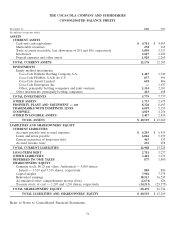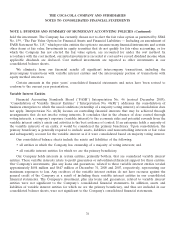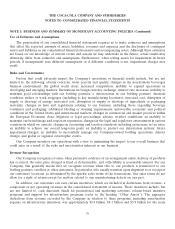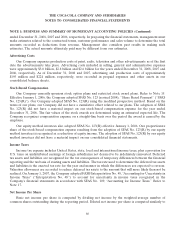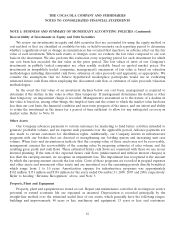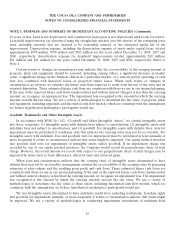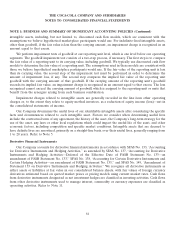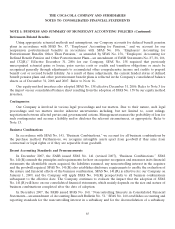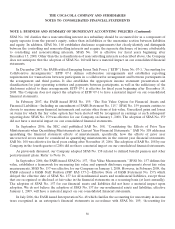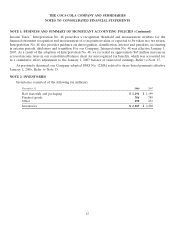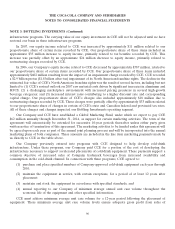Coca Cola 2008 Annual Report Download - page 85
Download and view the complete annual report
Please find page 85 of the 2008 Coca Cola annual report below. You can navigate through the pages in the report by either clicking on the pages listed below, or by using the keyword search tool below to find specific information within the annual report.THE COCA-COLA COMPANY AND SUBSIDIARIES
NOTES TO CONSOLIDATED FINANCIAL STATEMENTS
NOTE 1: BUSINESS AND SUMMARY OF SIGNIFICANT ACCOUNTING POLICIES (Continued)
10 years or less. Land is not depreciated, and construction in progress is not depreciated until ready for service.
Leasehold improvements are amortized using the straight-line method over the shorter of the remaining lease
term, including renewals that are deemed to be reasonably assured, or the estimated useful life of the
improvement. Depreciation expense, including the depreciation expense of assets under capital lease, totaled
approximately $993 million, $958 million and $763 million for the years ended December 31, 2008, 2007 and
2006, respectively. Amortization expense for leasehold improvements totaled approximately $19 million,
$21 million and $21 million for the years ended December 31, 2008, 2007 and 2006, respectively. Refer to
Note 4.
Certain events or changes in circumstances may indicate that the recoverability of the carrying amount of
property, plant and equipment should be assessed, including, among others, a significant decrease in market
value, a significant change in the business climate in a particular market, or a current period operating or cash
flow loss combined with historical losses or projected future losses. When such events or changes in
circumstances are present, we estimate the future cash flows expected to result from the use of the asset and its
eventual disposition. These estimated future cash flows are consistent with those we use in our internal planning.
If the sum of the expected future cash flows (undiscounted and without interest charges) is less than the carrying
amount, we recognize an impairment loss. The impairment loss recognized is the amount by which the carrying
amount exceeds the fair value. We use a variety of methodologies to determine the fair value of property, plant
and equipment, including appraisals and discounted cash flow models, which are consistent with the assumptions
we believe hypothetical marketplace participants would use.
Goodwill, Trademarks and Other Intangible Assets
In accordance with SFAS No. 142, ‘‘Goodwill and Other Intangible Assets,’’ we classify intangible assets
into three categories: (1) intangible assets with definite lives subject to amortization; (2) intangible assets with
indefinite lives not subject to amortization; and (3) goodwill. For intangible assets with definite lives, tests for
impairment must be performed if conditions exist that indicate the carrying value may not be recoverable. For
intangible assets with indefinite lives and goodwill, tests for impairment must be performed at least annually or
more frequently if events or circumstances indicate that assets might be impaired. Our equity method investees
also perform such tests for impairment of intangible assets and/or goodwill. If an impairment charge was
recorded by one of our equity method investees, the Company would record its proportionate share of such
charge. However, the actual amount we record with respect to our proportionate share of such charges may be
impacted by items such as basis differences, deferred taxes and deferred gains.
When facts and circumstances indicate that the carrying value of intangible assets determined to have
definite lives may not be recoverable, management assesses the recoverability of the carrying value by preparing
estimates of sales volume and the resulting gross profit and cash flows. These estimated future cash flows are
consistent with those we use in our internal planning. If the sum of the expected future cash flows (undiscounted
and without interest charges) is less than the carrying amount, we recognize an impairment loss. The impairment
loss recognized is the amount by which the carrying amount exceeds the fair value. We use a variety of
methodologies to determine the fair value of these assets, including discounted cash flow models, which are
consistent with the assumptions we believe hypothetical marketplace participants would use.
We test intangible assets determined to have indefinite useful lives, including trademarks, franchise rights
and goodwill, for impairment annually, or more frequently if events or circumstances indicate that assets might
be impaired. We use a variety of methodologies in conducting impairment assessments of indefinite-lived
83



